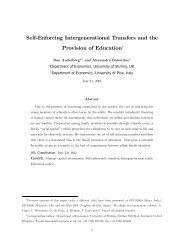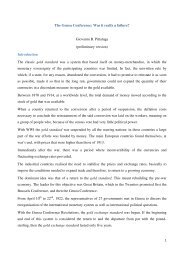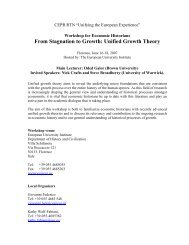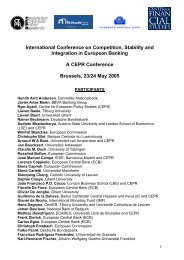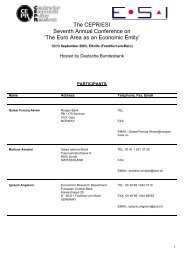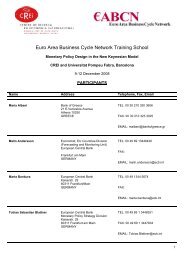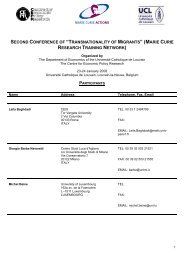MARKET STRUCTURE AND ENTRY: WHERE'S THE BEEF? - CEPR
MARKET STRUCTURE AND ENTRY: WHERE'S THE BEEF? - CEPR
MARKET STRUCTURE AND ENTRY: WHERE'S THE BEEF? - CEPR
Create successful ePaper yourself
Turn your PDF publications into a flip-book with our unique Google optimized e-Paper software.
those estimated for BK in 1991, but not thereafter (1.91 versus 1.69 respectively).<br />
Turning to the estimations that allow for unobserved heterogeneity, we find in<br />
column (5) that the coefficients in S(.) are little affected. The explanation for this is<br />
clearly the very low point estimate for ρM0 (0.03). The coefficients in V(.) react<br />
somewhat more: the coefficient of own outlets increases to 0.72 (from 0.55), the<br />
coefficient of the interaction term is now –0.2. Also, neither of the coefficients<br />
controlling for market definition remains significant. The estimate of fixed entry costs<br />
changes from 1.91 to 2.11. The random effect is again significantly correlated with rival,<br />
but not with own outlets. Importantly, however, our learning result is essentially<br />
unchanged: the coefficient of rival outlets in S(.) is now 0.87 (as opposed to 0.96 in<br />
column (4)), and significant at the 6% level. Estimating the model with linearly<br />
separable random effects (column (6)) shows that unobserved heterogeneity is not<br />
important. The point estimate (standard error) of ρM0 is 0.558 (0.503). Our estimates<br />
show that the random effect is negatively (but insignificantly) correlated with own, and<br />
positively with rival stock of outlets. Most of the (statistically significant) coefficients<br />
are very close to those in column (5). The coefficient of rival outlets in S(.), measuring<br />
firm learning is 0.778 (s.e. 0.299). Again, from the results of the error structure tests, we<br />
take the lesson that the standard probit provides an acceptable account of the data.<br />
Results in Table VI explore the learning effects in more detail. As with BK, the<br />
results are broadly in line with those in Table V, this time both in terms of sign and size<br />
of coefficients. The point estimates for McD outlets in S(.) for markets with own and no<br />
own outlets do not differ very much in size, and this time both are statistically significant.<br />
5.5. Summary and Discussion of Structural Results<br />
Estimating a (more) structural model produces substantial additional insights into<br />
29



